A roast capon features flavorful meat that is slightly sweeter than a regular chicken, with a delicate, velvety texture that melts in your mouth. The extra succulent, tender bird with crispy golden skin is perfect for serving as the centerpiece for any special occasion. This recipe is surprisingly easy to prepare, and with just a few simple ingredients, you'll have a delicious and impressive dish that everyone will love!
See my roasted rack of lamb, pork, or venison for more great special occasion main dishes!
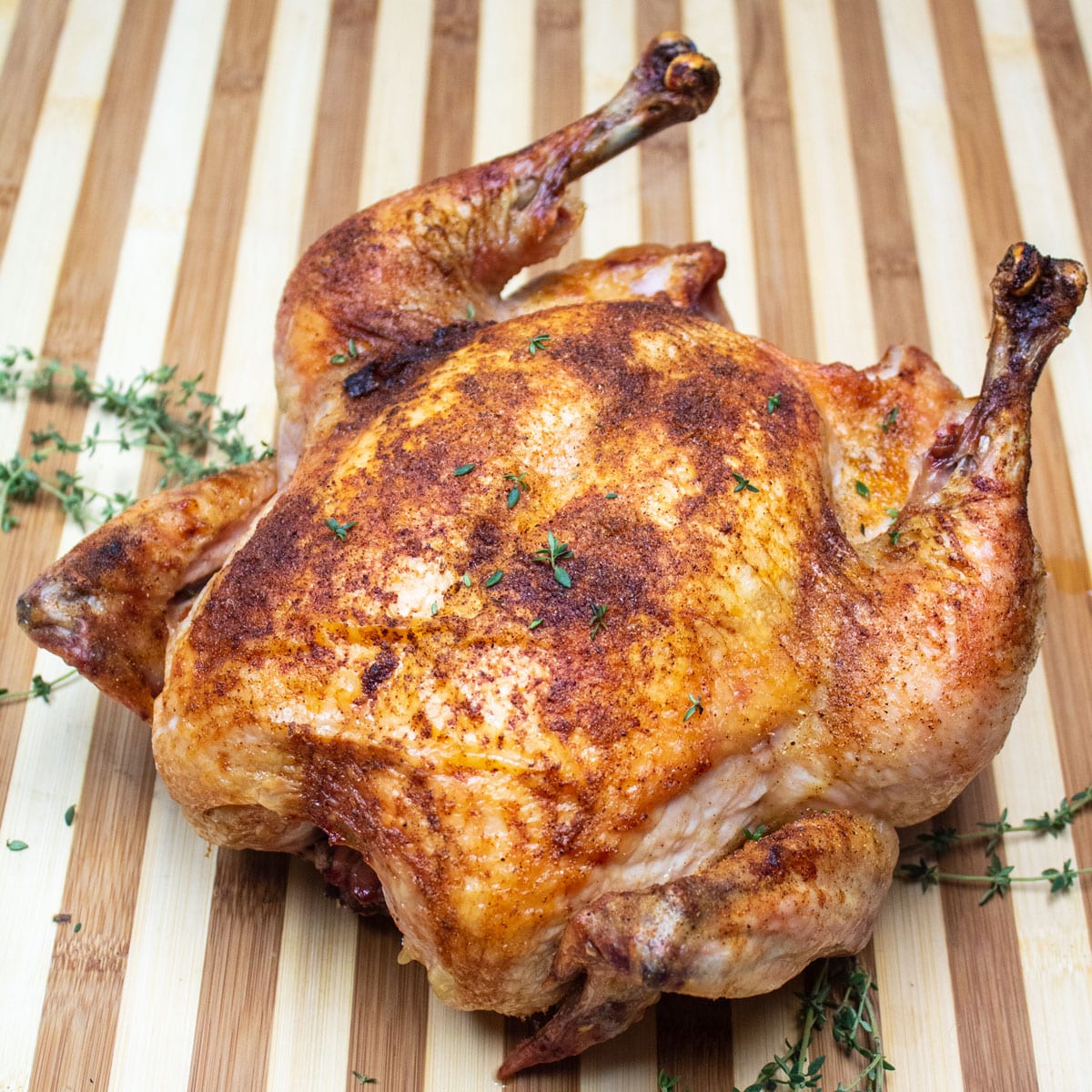
Jump to:
Best Whole Roast Capon Recipe
If you're looking to elevate your poultry game beyond the usual roasted chicken, then you have to try my roast capon. This delicious dish features succulent meat that has been slow-roasted to perfection with fresh herbs, seasoning, lemon, butter, garlic, and chicken broth.
Plus, a capon's impressive size and beautiful golden-brown skin are sure to amaze anyone who tries it. Whether you're serving it for a holiday feast or a sophisticated dinner party, you can't go wrong with this unique and flavorful bird.
What is a Capon?
A capon is a type of poultry that is larger and richer in flavor than chicken. It is the roaster from a male chicken (rooster) that has been castrated at a young age and then fed a special diet - typically of milk, porridge, corn, or a combination of these.
They are typically hormone and antibiotic-free and allowed to grow free-range. These chickens are raised for their meat, which is white, tender, and marbled (unlike most chicken meat). The flavor of capon is often compared to that of turkey.
Capons are typically more expensive than regular chicken and are considered a delicacy in some regions. They are often roasted and served as a main course for special occasions, holidays, or festive meals.
🥘 Ingredients
To make this whole roast capon, pick out a fresh capon and a handful of simple ingredients. Order a frozen capon if you can't find one locally. Try D'artagnan or Wild Fork Foods (I've ordered specialty meat from both companies).
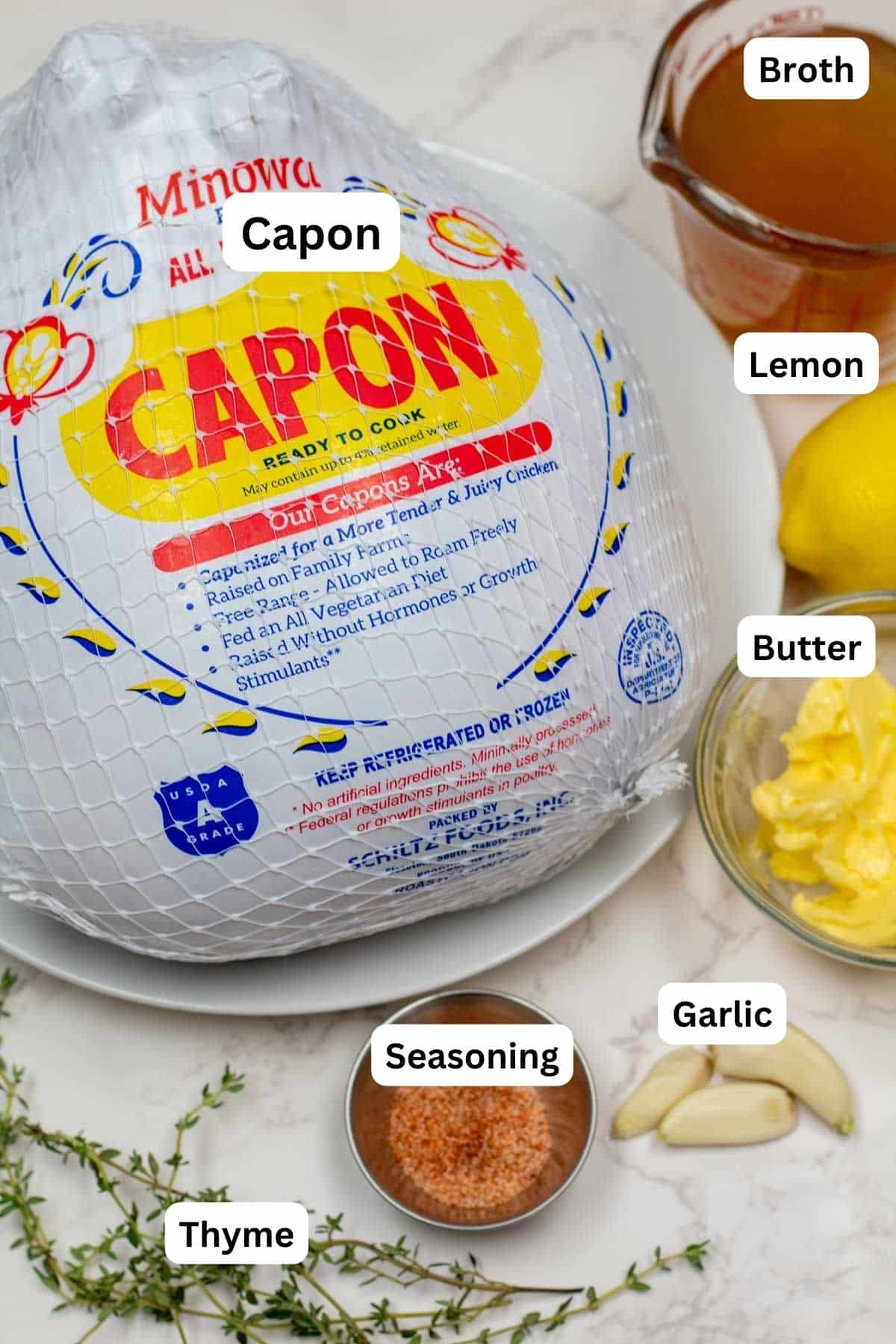
- Capon - Whole roaster, trimmed, and giblets removed.
- Salt & Pepper - Seasoning for inside the chicken.
- Fresh Herbs - Aromatics that are placed into the cavity of your roasting capon. Opt for my favorite chicken herbs - thyme, rosemary, sage, parsley, oregano, basil, summer savory, marjoram, and/or tarragon.
- Lemon - Quartered lemon for stuffing the chicken.
- Garlic - Crushed cloves are great aromatics for the capon, too.
- Butter - Softened butter is used to coat the skin of your capon, but you can also use some under the skin and over the breast meat.
- Chicken Broth - Placed into the roasting pan to catch the drippings and prevent them from scorching.
*Be sure to see the free printable recipe card below for ingredients, exact amounts & instructions with tips!*
🔪 How To Make Roast Capon
Roasting a capon requires some care and attention to ensure the meat is cooked properly and comes out juicy and flavorful! You will need a roasting pan with a roasting rack, a basting brush, a chef's knife, and a cutting board.
An 8-10 pound capon will be approximately 8 servings! There is plenty to share with the whole family, especially if you make some side dishes to go with it.
Prep & Stuff The Capon
Preheat. Preheat your oven to 350°F (175°C/Gas Mark 4). Rinse the 8-pound (3.63 kilograms) capon under cold running water and pat it dry with paper towels, then season inside the cavity with ½ teaspoon each, salt and pepper.
Stuff capon. Stuff the capon cavity with 4 sprigs of thyme, 4 sprigs of rosemary, lemon quarters, and 3-4 cloves of crushed garlic.

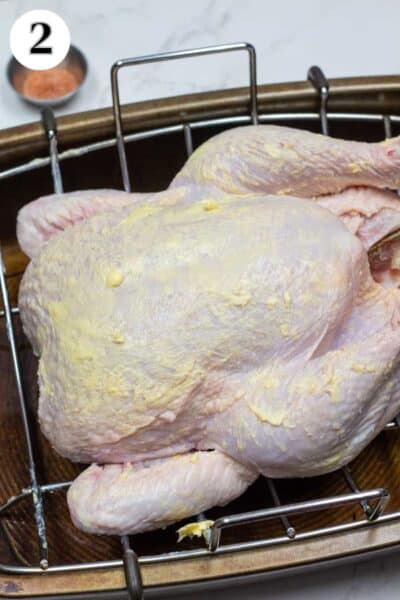
Transfer. Place the capon on a roasting rack in a roasting pan with the breast side up.
Season & Roast
Rub capon with butter. Rub the ½ cup (113.5 grams) of softened butter over the capon, covering the entire bird. Season with ½ tablespoon of chicken seasoning on all sides. Then, pour the 1 cup (236.59 milliliters) chicken broth into the bottom of the roasting pan.
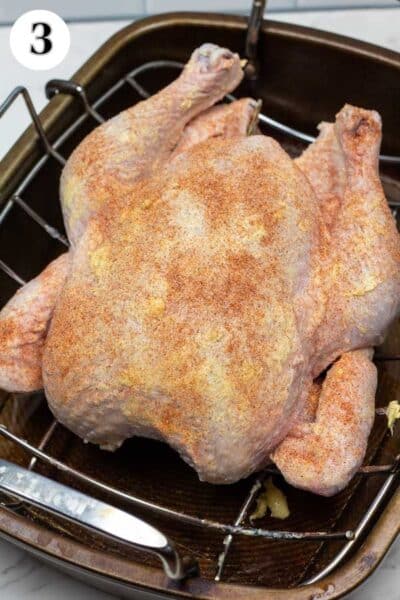

Cook. Roast the capon in the preheated oven at 350°F (175°C/Gas Mark 4) for approximately 2-3 hours, or 20 minutes per pound. Check the internal temperature of the thigh meat at the thickest point to ensure it reaches 165°F (74°C).
Rest & Serve
Rest. Remove your roasted capon from the oven, loosely tent a sheet of aluminum foil over it. Let it rest for 20-30 minutes before carving.
Serve. Serve the capon with your favorite side dishes.
Roast capon pairs well with a variety of side dishes so pick a few of your favorites to make a well-rounded meal. Try serving it with a roasted vegetable medley, cornbread stuffing, mashed potatoes, or a broccolini salad. Enjoy!
💭 Angela's Tips & Recipe Notes
- Butter under the skin. If desired, you can trace your fingers under the skin over the breast meat to loosen the skin. Rub some softened butter under the skin for extra juicy breast meat.
- Feel free to use the broth and pan drippings to make gravy to serve on top. For two different gravy methods, check out my article on how to make gravy with cornstarch!
- It is important to use a meat thermometer to check the internal temperature of the capon. This will ensure that the bird is cooked through and safe to eat.
- For a tidy appearance, you can opt to tie the legs together with kitchen twine.
- To keep the meat moist, baste the capon every 30 minutes with the juices from the bottom of the roasting pan if desired. *Note that opening the oven door to baste any roasting meat can reduce the oven temperature and increase cooking time.
- To ensure that the skin is crispy, you can start the capon at a higher temperature (around 425°F/218°C) for the first 20-30 minutes of cooking, then lower the temperature to 350°F (175°C) for the remainder of the cooking time.
- Letting the capon rest for a few minutes after it comes out of the oven will help the juices redistribute throughout the meat, resulting in a juicier and more flavorful bird.
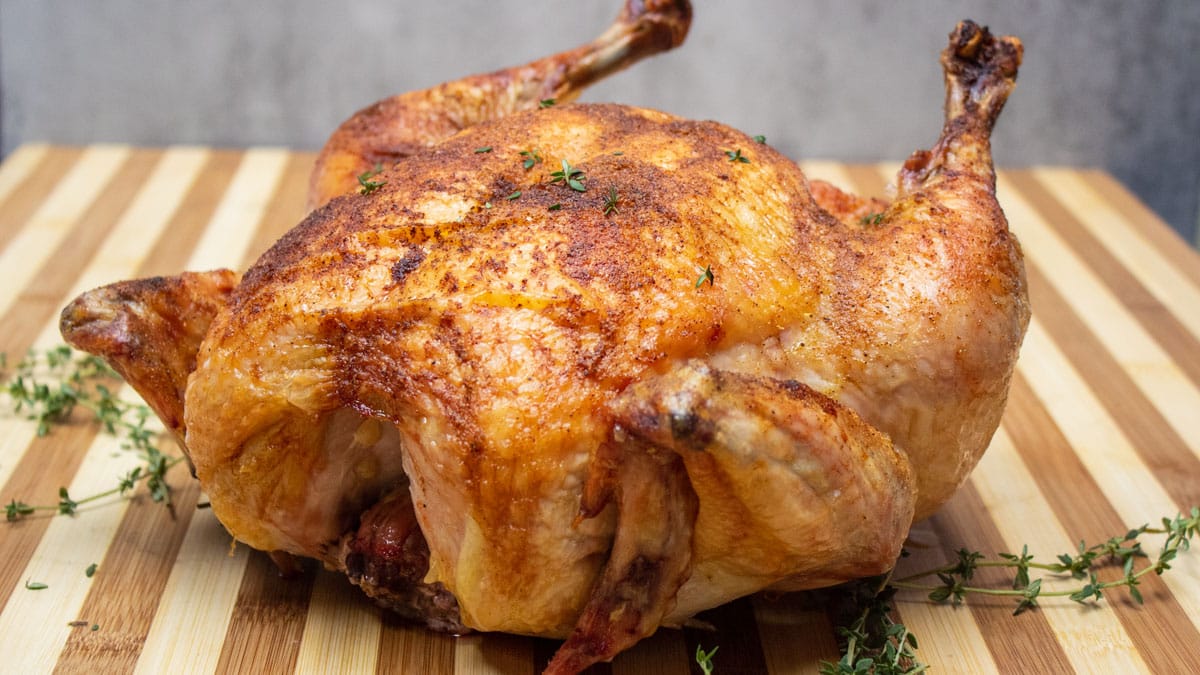
>>>See All Of My Tasty Recipes Here!<<<
🥡 Storing & Reheating
Refrigerate your cooked capon leftovers within 2 hours after roasting. Store it in an airtight container or a sealable plastic Ziploc bag for up to 3-4 days in the fridge.
Freezing
Wrap your capon leftovers with heavy-duty aluminum foil, then place them in a freezer storage bag. Write the date on the bag and enjoy it within 4 months. Thaw in the fridge overnight before reheating.
Reheating
Place your leftovers in a baking dish with some chicken broth or water and reheat in your oven at 350°F (175°C) until heated to your liking.
❓ Recipe FAQs
Capon is a type of poultry that is known for its tender meat and delicate flavor. The meat is often described as having a subtle, slightly sweet flavor that is less gamy than other types of poultry like chicken or turkey. It's also known for being very juicy and flavorful!
The main difference between a capon and a chicken is that a capon is a castrated rooster. Chicken is a bird of either gender. Capons are typically larger in size, and the meat of a capon is considered to be more tender and juicy.
Overall, capons are considered to be a high-quality and flavorful meat often used in gourmet cooking and special occasion meals. Chickens are a more versatile and widely-used meat.
This depends on personal taste preferences! A capon is a premium poultry product with a richer, more delicate flavor and a more tender texture than chicken. Capon meat has a higher fat content and a higher proportion of white meat. This gives it a milder and more subtle flavor compared to chicken.
Some people may prefer the stronger flavor and firmer texture of chicken. While others appreciate the succulent and tenderness of capon.
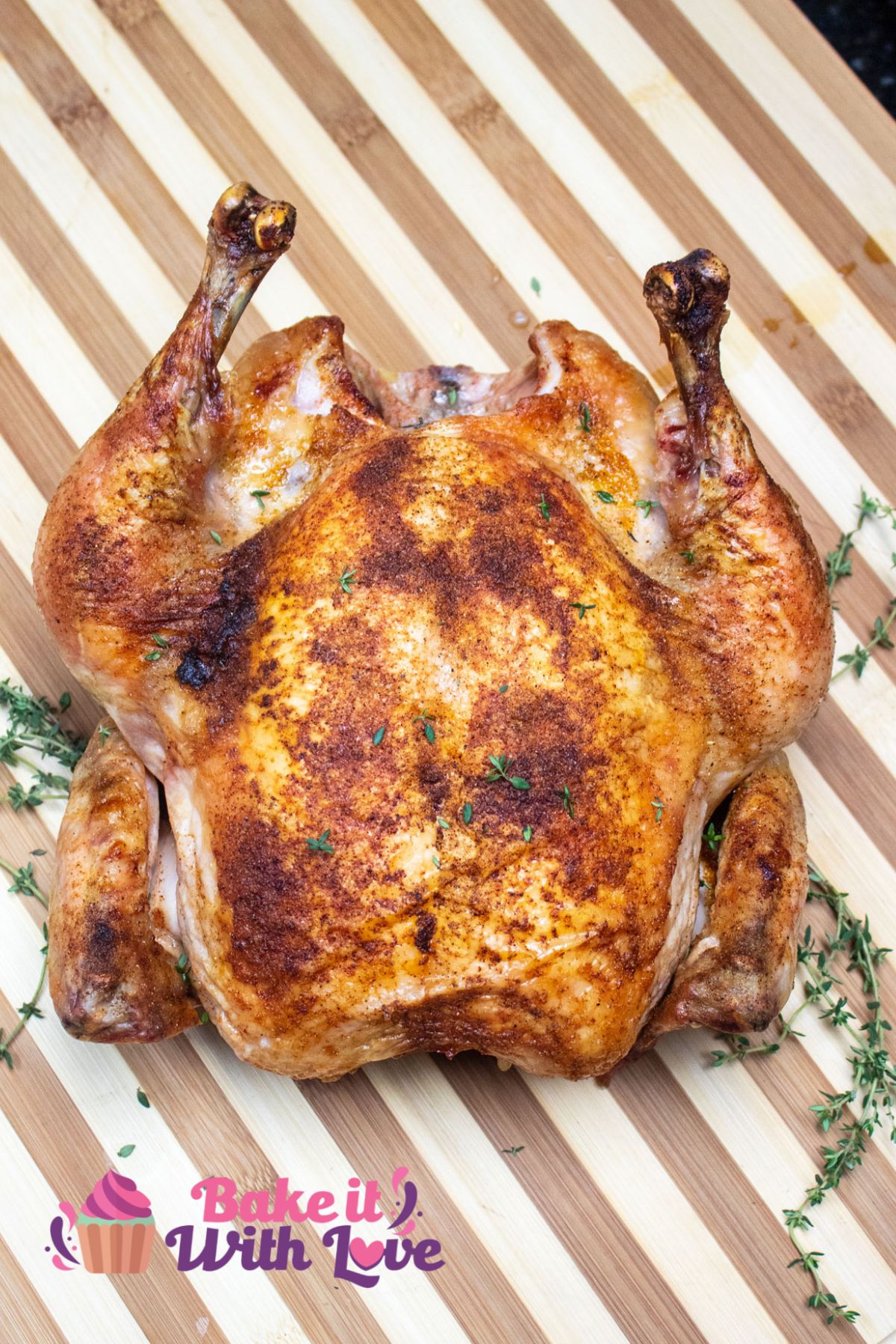
😋 More Delicious Poultry Recipes
- Crockpot Whole Chicken - This easy recipe is a great way to cook a rotisserie-style chicken at home!
- Whole Roasted Duck - If you're looking for a flavorful centerpiece for your next family meal, this recipe is it!
- Air Fryer Chicken Tenders - This air fryer recipe is an effortless way to make crispy and juicy chicken tenders!
- Air Fryer Cornish Hen - A tasty whole Cornish hen is incredibly easy to make in your air fryer!
- Sous Vide Chicken Breast - This recipe requires a handful of simple ingredients to make perfectly juicy chicken breasts!
- Roasted Pheasant - A roasted pheasant is simple, comforting, and perfect to serve on any occasion!
Do you love a recipe you tried? Please leave a 5-star 🌟rating in the recipe card below and/or a review in the comments section further down the page.
Stay in touch with me through social media @ Pinterest, Facebook, Instagram, or Twitter! Subscribe to the newsletter today (no spam, I promise)! Don't forget to tag me when you try one of my recipes!
📖 Recipe Card
Roast Capon
Ingredients
- 8 lbs capon (8 to 10 pounds, rinsed and pat dry)
- ½ teaspoon each, salt & pepper (to taste)
- 4 sprigs fresh thyme (4-5 sprigs)
- 4 sprigs fresh rosemary (4-5 sprigs)
- 1 large lemon (cut into quarters)
- 3-4 cloves garlic (crushed)
- ½ cup butter (softened, at room temperature)
- ½ tablespoon chicken seasoning (see recipe, or use your favorite brand)
- 1 cup chicken broth
(Note: 2x or 3x only changes the ingredient list)
Instructions
- Preheat your oven to 350°F (175°C/Gas Mark 4). Rinse the 8 lbs capon under cold running water and pat it dry with paper towels, then season inside the cavity with ½ teaspoon each, salt & pepper.
- Stuff the capon cavity with 4 sprigs fresh thyme, 4 sprigs fresh rosemary, 1 large lemon quarters, and 3-4 cloves garlic.
- Place the capon on a roasting rack in a roasting pan with the breast side up.
- Rub the softened ½ cup butter over the capon, covering the entire bird. Season with ½ tablespoon chicken seasoning on all sides, then pour the 1 cup chicken broth into the bottom of the roasting pan.
- Roast the capon in the preheated oven at 350°F (175°C/Gas Mark 4) for approximately 2-3 hours, or 20 minutes per pound. Check the internal temperature of the thigh meat at the thickest point to ensure it reaches 165°F (74°C).
- Remove your roasted capon from the oven, loosely tent a sheet of aluminum foil over it, and let it rest for 20-30 minutes before carving.
- Serve the capon with your favorite side dishes.
Notes
- If desired, you can trace your fingers under the skin over the breast meat to loosen the skin. Rub some softened butter under the skin for extra juicy breast meat.
- Feel free to use the broth and pan drippings to make gravy to serve on top. For two different gravy methods, check out my article on how to make gravy with cornstarch!
- It is important to use a meat thermometer to check the internal temperature of the capon. This will ensure that the bird is cooked through and safe to eat.
- For a tidy appearance, you can opt to tie the legs together with kitchen twine.
- To keep the meat moist, baste the capon every 30 minutes with the juices from the bottom of the roasting pan if desired. *Note that opening the oven door to baste any roasting meat can reduce the oven temperature and increase cooking time.
- To ensure that the skin is crispy, you can start the capon at a higher temperature (around 425°F/218°C) for the first 20-30 minutes of cooking, then lower the temperature to 350°F (175°C) for the remainder of the cooking time.
- Letting the capon rest for a few minutes after it comes out of the oven will help the juices redistribute throughout the meat, resulting in a juicier and more flavorful bird.
- To store: Refrigerate your cooked capon leftovers within 2 hours after roasting. Store it in an airtight container or a sealable plastic Ziploc bag for up to 3-4 days in the fridge.
- To freeze: Wrap your capon leftovers with foil then place it in a heavy-duty freezer bag. Write the date on the bag and enjoy it within 4 months. Thaw in the fridge overnight before reheating.
- To reheat: Place your leftovers in a baking dish with some chicken broth or water and reheat in your oven at 350°F (175°C) until it is heated to your liking.
Nutrition
Originally published March 6, 2023
Updated May 1, 2024, with new photos and process pictures, fixed grammar and formatting



Angela says
Thank you! Best roast I've ever done and it was easy thanks to your precise directions.
Do I discard the lemon wedges after it's cooked?
Angela @ BakeItWithLove.com says
Yes, the lemon can be discarded before serving. You can also squeeze them (carefully) into the drippings if you'd like to make a gravy. Thanks for asking and for sharing your success!
Anonymous says
Thank you so much.. just seeing your comment now as I came back to make it again. Still delicious!